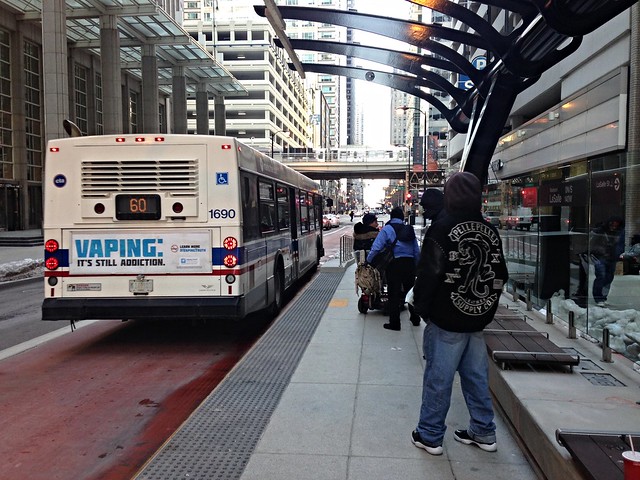[The Chicago Reader recently launched a new weekly transportation column written by Streetsblog Chicago editor John Greenfield. This partnership will allow Streetsblog to extend the reach of our livable streets advocacy. We’ll be syndicating a portion of the column on the day it comes out online; you can read the remainder on the Reader’s website or in print. The paper hits the streets on Thursdays.]
The city hopes the Loop Link bus rapid transit corridor, a bold reconfiguration of street space, will double the speed of buses crossing the central business district from the previous glacial rush-hour pace of 3 mph. The $41 million project was designed to provide an express route for buses traveling between Michigan Avenue and the West Loop.
The heart of the system is on Washington and Madison Streets, where mixed-traffic lanes were transformed into red bus-only lanes and raised boarding platforms featuring huge, rakelike shelters and plentiful seating, plus a green protected bike lane on Washington. Six daily CTA bus lines that terminate in various corners of the city are now using the route, including the #J14 Jeffery Jump, #20 Madison, #56 Milwaukee, #60 Blue Island/26th, #124 Navy Pier, and #157 Streeterville/Taylor.
Immediately after the system debuted on Sunday, December 20, some bus riders and BRT boosters were disappointed that there seemed to be little or no improvement in trip times. This was partly due to a CTA policy that requires bus operators to cautiously creep into the platform stations.
When I rode the Madison bus downtown from the west side during the evening rush on the Tuesday after the system launched, it took a full 16 minutes to travel the 0.8 miles between Canal Street and Michigan Avenue. That's 3 mph, the same speed as before Loop Link was established, when buses were stuck in car-generated traffic jams.
I overheard several commuters complaining about the new system. A couple of them strategized about different bus lines they could take to avoid the BRT corridor.
At the time, CTA spokeswoman Tammy Chase told me that bus drivers are currently instructed to drive no faster than 3 mph alongside the stations. That's because the raised platforms are elevated a foot or so above sidewalk level, which means that people who stand in the dark gray, textured area near the platform edge are in danger of being struck by the buses' rearview mirrors.
Chase added that bus drivers can go the normal 30 mph speed limit on other parts of the route. She implied that as bus operators and customers get used to the system, the speed restriction by the platforms would be raised.
As of last Tuesday, the 3 mph speed limit by platforms was still in place, according to CTA spokesman Jeff Tolman. However, bus speeds appear to have increased a bit overall since the launch, as operators and other road users have grown more comfortable with the new layout. Moreover, a leading authority on BRT says growing pains are normal when a new system launches.
Early January traffic may be a bit lighter than the hectic days leading up to Christmas. But when I rode the system several times during peak hours on Tuesday, most of my bus drivers seemed to be a little more at ease navigating the system than before.
Read the rest of the post on the Chicago Reader website.






